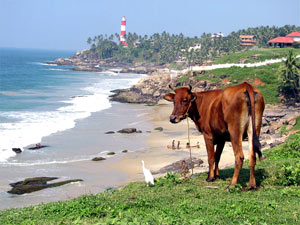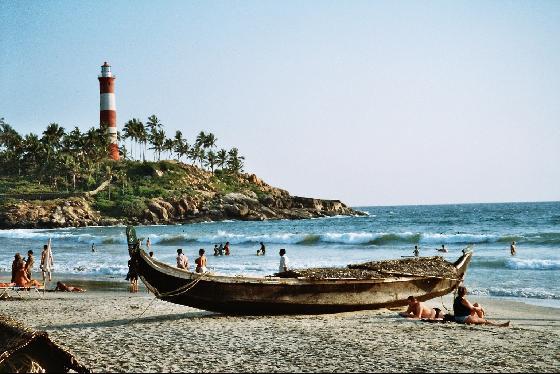|
KOVALAM
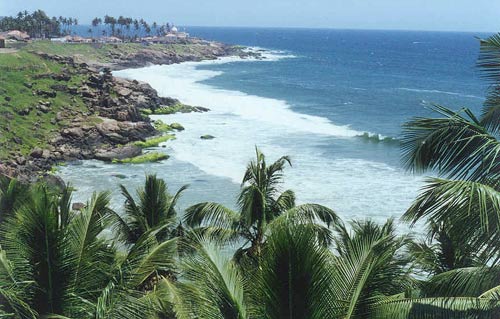
Kovalam
is a quiet little town with greenery all around. Coconut, bananas,
pineapples,
papayas, ginger, mangoes etc are its wealth. Two beautiful adjacent
bays
bestow glamour to Kovalam.
See and
admire the three crescents beaches : Lighthouse Beach, Hawa Beach and
Ashoka
Beach that Kovalam is famous for.
The
southernmost Lighthouse Beach commands highest degree of popularity.
Eve’s
Beach, more commonly known as Hawa Beach, ranks second. All the three
are
very popular, the difference being narrow.
The
name Lighthouse is voluntarily awarded by the pet old Vizhinjam
Lighthouse
anchored on a rocky promontory. Its intermittent glittering beams at
night
bestow cost-free charm of romantic hours at Kovalam.
An
Edakallu
(a stone in between) separates Hawa Beach from Lighthouse Beach. Hawa
Beach
is fairly clean. A rocky hill separates Ashoka Beach from Hawa Beach.
Halcyon
Castle, one of Kovalam’s landmarks, is located at Ashoka Beach.
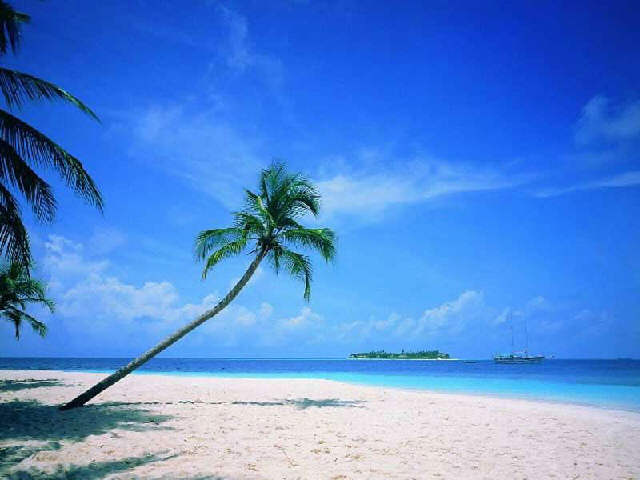
Take
a detour past Kovalam junction to land in Samundra Beach which is at
north
of Ashoka Beach. A long sea-wall gives the option of walk on. The waves
lashing on rocks below are a pretty sight.
Cherished
monsoon at Kovalam : India’s
south-west
monsoon kick-starts from Kovalam. The sky drops its milk first to the
sea
waters in Kovalam with thunder and lightning (very often) as a
proclamation
of its arrival and moves to the land. Prelude to the monsoon mild to
harsh
wind emanates from south-west direction in the sea and moves on to the
land. This happens 7-8 hours in advance of the arrival of monsoon. The
cloud-drops nose-dive to the sea artistically to punch the sea-water
which
is a heart-warming sight. The people enjoy drenching in the first rain.
The rain comes and the people get a sigh of relief from scorching heat,
often around 42 degree Celsius.
The
people world over confirm Kovalam is the best place to imbibe the charm
and beauty of the arrival of monsoon. Many litterateurs, documentary
writers,
channels and televisions including BBC television prefer Kovalam to
document
the monsoon arrival.
Ayurveda
Kovalam : Kovalam has become a fertile
land for Ayurvedic outlets in various hues such as ashrams, spas,
clinics,
centres and resorts consequent upon the 3000-year old science of
Ayurveda
becoming Kerala’s big tourist attraction.
Vizhinjam
is known as fishing village. It is just 2-km south of Kovalam.
Vizhinjam
Fishing Harbour is a natural port which is about to be developed as a
major
port for which spade work is already in progress. It is the busiest
fishing
harbour in Thiruvananthapuram district humming with activities all the
days. The sight of hundreds of fishing boats crowding on the harbour is
delighting. See them from distance as the fish-foul smell is nauseating.
There
is a Marine Aquarium near Theatre junction. Though housed in a shabby
building,
it is a treasure of marine products. Clownfish of Finding Nemo fame,
moon
wrasse, squirrelfish, lionfish, butterflyfish, giant turtles,
triggerfish,
aggressive surgeonfish, deadly piranhas, sharks etc are few among the
many
nursed here.

The
Aquarium has mastered in the
image-pearl
production technique. The technic seems simple but needs perfection. A
mould made of lime is implanted into the pearl oyster. After two to
three
months a moulded pearl is ready. The images of Christ, Virgin Mary,
idols
of Hindu gods and goddesses are displayed in the Aquarium.
There
is an 18th century old Cave Temple near Vizhinjam junction. It has
semi-carved
idol of Shiva and goddess Parvathi on the outside. Inside there is a
single-celled
shrine. Being a Cave Temple (very few in Kerala) many devotees and
others
visit here. As against other temples, one day, that is Monday, is
closed
here.
Chowara,
just 6-km south of Vizhinjam, is a fishing village. It has a long
stretch
of white sanded quiet beach. Being a fishing village, it is a common
delightful
sight that eagles and kites circle above the sea near the beach.
There
is a hill-top Ayyappa temple which overlooks the beach. Here there is a
56-day long festival beginning from November 15 and ending on January
15
which is attended by many.
Nearby
Chowara there is Azhimalathura beach which stretches long. This is the
only beach in Kerala not eroded by sea. In contrast, the sea is
receding
here.
The hill-top
Pulikudi-Azhimala Shiva temple is near here. The surroundings of the
temple
are lovely and enchanting.
Analothbhava
Matha church is also located here on the beach side. This is a very
ancient
church. Sunday, Monday and Friday are the Mass days.
Thiruvallam,
8-km north of Kovalam, is the place where Killi and Karamana rivers
embrace
each other. Thiruvallam Boat Club arranges boat ride to Karamana and
back.
Nearby,
there is a quiet beach called Pozhikkara beach where Parvathy Puthanaar
river and Karamana river succumb to the sea.
Kerala
has only one temple dedicated to the legendary creator of Kerala,
Parasurama,
which is located near here. The devotees and others throng to this
shrine.
Here the main festival is Arattu in the month of Thulam
(Oactober-November).
Vavu Bali is also conducted in Karkidakam (July-August) when large
number
of Hindus gathers to perform rites for the departed souls of dear and
near
ones.
Located
7-km from Kovalam via Poonkulam junction. The 750-hectre giant lake is
a freshwater lake, one of the two in Kerala. The other one is in
Sasthamkotta
in Kollam district. A road passes through this lake, a rare sight. This
lake attracts many people. Once in Kovalam, a visitor should not allow
to miss the opportunity of seeing this wonder lake of freshwater. Its
crystal-clear
calm water, especially during moonlit nights, is a craze for the minds.
The locals say a side of the lake is Kochu Kovalam, meaning tiny
Kovalam.
There
is a boat race in the lake during Onam which attracts huge crow.
Country
boat is available from Kovalam beach to reach the lake.
300-acre
campus of Government Agricultural College is nearby. The main building
of the College was built by the erstwhile Travancore royal family as
their
summer palace.
There
is a Devi temple 300-m away from the lake. A festival called Vellayani
Mahotsav is celebrated in the temple once in every three years. The
festival
prolongs to 54 days. The next festival is due in 2008
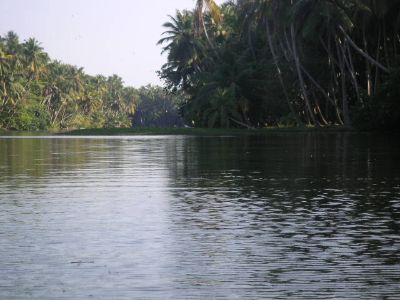
Back
to main page
|

